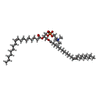+Search query
-Structure paper
| Title | Structure of human GABA receptor in an inactive state. |
|---|---|
| Journal, issue, pages | Nature, Vol. 584, Issue 7820, Page 304-309, Year 2020 |
| Publish date | Jun 24, 2020 |
 Authors Authors | Jinseo Park / Ziao Fu / Aurel Frangaj / Jonathan Liu / Lidia Mosyak / Tong Shen / Vesna N Slavkovich / Kimberly M Ray / Jaume Taura / Baohua Cao / Yong Geng / Hao Zuo / Yongjun Kou / Robert Grassucci / Shaoxia Chen / Zheng Liu / Xin Lin / Justin P Williams / William J Rice / Edward T Eng / Rick K Huang / Rajesh K Soni / Brian Kloss / Zhiheng Yu / Jonathan A Javitch / Wayne A Hendrickson / Paul A Slesinger / Matthias Quick / Joseph Graziano / Hongtao Yu / Oliver Fiehn / Oliver B Clarke / Joachim Frank / Qing R Fan /    |
| PubMed Abstract | The human GABA receptor-a member of the class C family of G-protein-coupled receptors (GPCRs)-mediates inhibitory neurotransmission and has been implicated in epilepsy, pain and addiction. A unique ...The human GABA receptor-a member of the class C family of G-protein-coupled receptors (GPCRs)-mediates inhibitory neurotransmission and has been implicated in epilepsy, pain and addiction. A unique GPCR that is known to require heterodimerization for function, the GABA receptor has two subunits, GABA and GABA, that are structurally homologous but perform distinct and complementary functions. GABA recognizes orthosteric ligands, while GABA couples with G proteins. Each subunit is characterized by an extracellular Venus flytrap (VFT) module, a descending peptide linker, a seven-helix transmembrane domain and a cytoplasmic tail. Although the VFT heterodimer structure has been resolved, the structure of the full-length receptor and its transmembrane signalling mechanism remain unknown. Here we present a near full-length structure of the GABA receptor, captured in an inactive state by cryo-electron microscopy. Our structure reveals several ligands that preassociate with the receptor, including two large endogenous phospholipids that are embedded within the transmembrane domains to maintain receptor integrity and modulate receptor function. We also identify a previously unknown heterodimer interface between transmembrane helices 3 and 5 of both subunits, which serves as a signature of the inactive conformation. A unique 'intersubunit latch' within this transmembrane interface maintains the inactive state, and its disruption leads to constitutive receptor activity. |
 External links External links |  Nature / Nature /  PubMed:32581365 / PubMed:32581365 /  PubMed Central PubMed Central |
| Methods | EM (single particle) |
| Resolution | 3.3 Å |
| Structure data | EMDB-21685, PDB-6wiv: |
| Chemicals |  ChemComp-NAG:  ChemComp-CA:  ChemComp-U3G:  ChemComp-CLR:  ChemComp-U3D: |
| Source |
|
 Keywords Keywords | MEMBRANE PROTEIN / G protein coupled receptor (GPCR) / GABA / GABA(B) receptor / Class C GPCR / Phospholipids / Inhibitory neurotransmission. |
 Movie
Movie Controller
Controller Structure viewers
Structure viewers About Yorodumi Papers
About Yorodumi Papers





 homo sapiens (human)
homo sapiens (human)